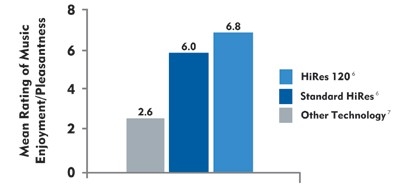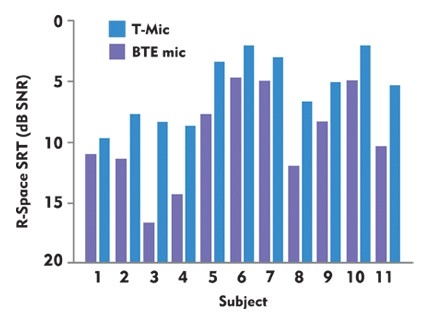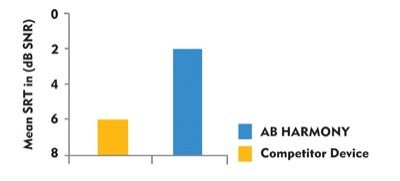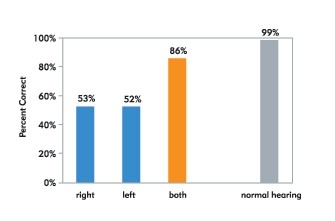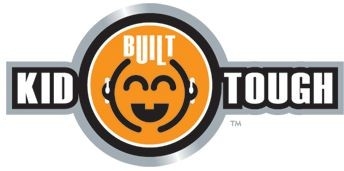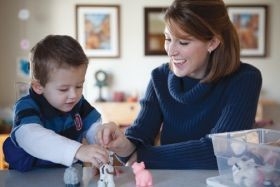
Pediatric Cochlear Implant Patient Materials
AB provides informative materials that help parents of your pediatric patients understand the process and rewards of getting a cochlear implant.
Download brochures, share webinars, print patient literature, and review professional studies to show your patients’ parents how cochlear implants are designed to function and improve quality of life.
The Journey to Getting a Cochlear Implant
AB’s literature will help parents of your pediatric patients understand their child’s process of getting a cochlear implant, from initial diagnosis to implantation, activation, and beyond.
HiRes Fidelity 120 for Speech Development
Advanced Bionics cochlear implant systems offer HiRes Fidelity 120™*, which delivers five times more resolution than any other cochlear implant.
AB’s superior technology is designed to allow your pediatric patients to hear their best in the real world providing the closest to normal hearing of any cochlear implant.
Your patients can hear all the details necessary to develop clear, strong speech patterns and excel academically like their normal-hearing peers.
*Not approved for pediatric patients in the US.
HiRes Fidelity 120 for Music Appreciation
AB’s HiRes Fidelity 120™* is designed to deliver the pitch and timing of sound with the greatest accuracy so that your pediatric patients can hear and enjoy music.
Only HiRes Fidelity 120 from AB:
- Offers 120 spectral bands for unsurpassed spectral resolution. Other implants limit stimulation to one electrode at a time, which limits the number of spectral bands to the number of electrodes (at most 22).
- Provides simultaneous electrode stimulation allowing current to be “steered“ between electrodes giving AB recipients 120 spectral bands for better hearing.
- Allows patients to hear many more pitches than the number of electrodes implanted in the ear.
- Has been proven in studies to show better speech perception in noise, as well as improvements in music and sound quality compared to other sound-processing strategies.1-3
*Not approved for pediatric patients in the US.
Study Demonstrates AB Recipients Enjoy Music
In a multicenter study, researchers demonstrated that AB recipients listen to music more frequently and enjoy the music-listening experience more than recipients of other cochlear implant systems.4,5
Improved Hearing in Noise with the T-Mic
Whether your pediatric patient is at school, at a birthday party, or playing at the park, they will want to easily interact with their playmates and classmates, rather than struggle to keep up. AB performs best in these challenging situations.
Gifford showed that 11 out of 11 recipients understood more sentences in noise with AB’s unique T-Mic™ microphone than with a behind-the-ear (BTE) mircophone.6
Easy, Hands-Free Hearing with AutoSound
AB’s unique AutoSound™ technology automatically adapts to changing listening environments so that your pediatric patients can easily hear people speaking in everyday settings.
With AutoSound, children can focus on writing, running, or playing instruments rather than fumbling with dials to adjust their sound processor.
Independent research by Haumann, Buchner, and Lenarz concluded that AB recipients hear speech in noise and everyday life situations better than recipients of other cochlear implant systems.7
Kids Hear Better with Bilateral Implants
While a single cochlear implant will help pediatric patients, two cochlear implants provide measurable advantages. Bilateral cochlear implants help pediatric patients8-10:
- Focus and hear better in noisy environments like the classroom or on the playground.
- Develop more natural speech by delivering more audio stimulation to a child’s brain during critical speech development years.
- Localize sound more easily.
- Listen with less effort.
- Not worry about where to sit in a classroom to hear well.
Built Kid Tough
AB’s cochlear implant systems are Built Kid Tough™ so they can withstand real-world conditions. AB’s systems feature:
- Flexible wearing options designed to grow with your child from infancy to adulthood
- Advanced water protection that’s guaranteed
- Fully programmable childproof controls that are easy to see and use
- Eco-friendly, rechargeable battery options that are easy to change and last for years
- AB’s proprietary Intellilink™ safety feature that sends information only to a child’s implants, preventing swapping between users and bilateral mismatches
- Accessories like the Kinder Clip™ and Snuggie™ that are designed to allow for more freedom of movement
- FM compatibility for easy use in classrooms
Connect Your Patients’ Parents to the BEA
The Bionic Ear Association (BEA) strives to improve the quality of life of individuals with severe-to-profound hearing loss by providing information, education, awareness, and guidance on cochlear implants.
By connecting parents of pediatric patients to the BEA, and specifically to a BEA Mentor, you’ll help parents find peer-to-peer support and lay the foundation for greater success with their child’s cochlear implant.
You can also introduce your pediatric patients to the Bionic family: Bionic Buddy, his sister Melody, his parents, and the family dog. These characters help children better understand the process of getting one or two cochlear implants.
Connect Your Patients’ Parents to the BEA
The Listening Room™ is a one-of-a-kind website that gives your patients a foundation of interactive and uniquely designed practice activities in English to improve their listening skills so that communicating with others is a successful experience.
Exercises can be done alone; with a therapist, parent, or listening coach; on paper; or with an iPod/MP3 player.
Tools for Schools
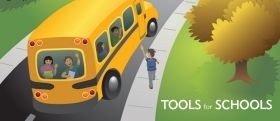
AB’s Tools for Schools™ offers a variety of great resources to support the educational management and rehabilitative therapy of pediatric unilateral or bilateral cochlear implant recipients.
References
Firszt JB, Holden L, Reeder R, Skinner MW. 2009. Spectral Channels and Speech Recognition in Cochlear Implant Recipients using HiRes 120 Sound Processing. Otology and Neurotology 30:146-152.
Brendel M, Buchner A, Kruger B, Frohne-Buchner C, Lenarz T. 2008. Evaluation of the Harmony Sound Processor in Combination with the Speech Coding Strategy HiRes 120. Otol Neurotology 29:199-202.
Oleson J, Lesh S, Gfeller K, Knutson J. The Effect of Advanced Bionics’ HiRes 120 on Self-Report of Music Enjoyment. Poster Presentation at the 10th International Conference on Cochlear Implants and Other Implantable Auditory Technologies, April 10-12, 2008, San Diego, CA.
Quick A, Koch DB, Osberger MJ. HiResolution with Fidelity 120 Sound Processing: Listening Benefits in CII and HiRes 90K Implant Users. Poster Presentation at the Conference on Implantable Auditory Prostheses, July 15-20, 2007, Lake Tahoe, CA.
Mirza S, Douglas SA, Lindsey P, Hildreth T, Hawthorne M. 2003. Appreciation of Music in Adult Patients with Cochlear Implants. Cochlear Implants International. 4(2): 85-95.
Gifford R. Speech Perception in a Realistic Background Noise: Effectiveness of Preprocessing Strategies and External Options for Improving the Signal-to-noise Ratio. Presentation at the 10th International Conference on Cochlear Implants and Other Implantable Auditory Technologies, San Diego, CA, April 10–12, 2008.
Haumann S, Buchner A, Lenarz Th. Does the Input Dynamic Range of Cochlear Implant Processors Influence Speech Perception in Adverse Listening Situations? Oral Presentation at the 10th International Conference on Cochlear Implant and Other Implantable Auditory Technologies, San Diego, CA. April 10-12, 2008.
Koch DB, Soli SD, Downing M, Osberger MJ. Simultaneous bilateral cochlear implantation prospective study in adults. Presentation at the American Neurology Society, San Diego, California, 24 April 2007.
Zeitler D, et al. 2008. Speech Perception Benefits of Sequential Bilateral Cochlear Implantation in Children and Adults: A Retrospective Analysis. Otology & Neurotology. 29 (3): 314–325.
Dunn, C, et al. 2008. Comparison of Speech Recognition and Localization Performance in Bilateral and Unilateral Cochlear Implant Users Matched on Duration of Deafness at Age of Implantation. Ear and Hearing. 29 (3): 352–359
